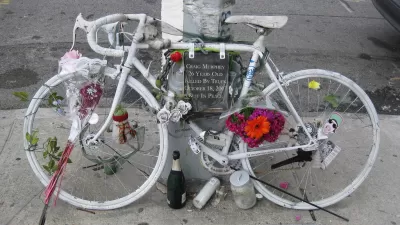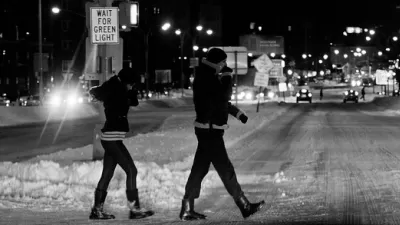Traffic deaths dropped by 27 in 2015 to 230, a reduction of over 10 percent from 2014. Pedestrian deaths decreased only slightly. Bicyclists fared better: deaths dropped by 30 percent.
"Even though such deaths declined, city officials and traffic-safety groups agreed that more aggressive steps must be taken to reach Mayor Bill de Blasio’s goal of eliminating traffic deaths in the city by 2024, as part of a plan called Vision Zero that he announced nearly two years ago," writes Emma G. Fitzsimmons of The New York Times.
"Pedestrian deaths, which account for the largest share of the fatalities, dropped slightly last year after reaching a historic low in 2014," adds Fitzsimmons. The 133 recorded fatalities amounts to 58 percent of total traffic deaths.
In 2015, 133 pedestrians died in traffic crashes, according to city data, though officials cautioned that the figures could change after the cases were more closely examined. Last January, the city reported 132 pedestrian deaths for 2014, but that number later rose to 139 — still the lowest total on record and down significantly from 183 deaths in 2013.
The Vision Zero program enters its third year with the strong backing of Mayor Bill de Blasio.
“We are moving in the right direction,” the mayor said in an interview. “We know there is a lot more to do, but there is no question that Vision Zero is working.”
A few bullet points on how the program, which featured various safety improvements, such as "lowering the default speed limit to 25 miles per hour" (See NYC Vision Zero Action Plan for more details), fared in 2015.
- Traffic deaths are down in every borough with one notable exception: Staten Island.
- Greatest reduction in traffic deaths occurred for those riding on two wheels:
- Bicycle fatalities dropped by 30 percent, from 20 to 14.
- Motorcyclists saw the greatest improvement: deaths reduced by over 40 percent, from 37 to 22.
- No change for those riding in motor vehicles: 61 deaths.
Fitzsimmons writes that Vision Zero is "modeled after a Swedish approach that treats all road deaths and serious injuries as inherently preventable." An accompanying photo shows the traffic-safety group Families for Safe Streets, marching in November carrying signs stating, "I pledge to use 'Crash not Accident'" to reinforce the preventable nature of traffic injuries and fatalities. The message on their "pledge" webpage:
Traffic crashes are fixable problems, caused by dangerous streets and unsafe drivers. They are not accidents. Let’s stop using the word "accident" today.
FULL STORY: Number of Traffic Deaths in New York Falls for a Second Straight Year

Planetizen Federal Action Tracker
A weekly monitor of how Trump’s orders and actions are impacting planners and planning in America.

Restaurant Patios Were a Pandemic Win — Why Were They so Hard to Keep?
Social distancing requirements and changes in travel patterns prompted cities to pilot new uses for street and sidewalk space. Then it got complicated.

Map: Where Senate Republicans Want to Sell Your Public Lands
For public land advocates, the Senate Republicans’ proposal to sell millions of acres of public land in the West is “the biggest fight of their careers.”

Maui's Vacation Rental Debate Turns Ugly
Verbal attacks, misinformation campaigns and fistfights plague a high-stakes debate to convert thousands of vacation rentals into long-term housing.

San Francisco Suspends Traffic Calming Amidst Record Deaths
Citing “a challenging fiscal landscape,” the city will cease the program on the heels of 42 traffic deaths, including 24 pedestrians.

California Homeless Arrests, Citations Spike After Ruling
An investigation reveals that anti-homeless actions increased up to 500% after Grants Pass v. Johnson — even in cities claiming no policy change.
Urban Design for Planners 1: Software Tools
This six-course series explores essential urban design concepts using open source software and equips planners with the tools they need to participate fully in the urban design process.
Planning for Universal Design
Learn the tools for implementing Universal Design in planning regulations.
Heyer Gruel & Associates PA
JM Goldson LLC
Custer County Colorado
City of Camden Redevelopment Agency
City of Astoria
Transportation Research & Education Center (TREC) at Portland State University
Camden Redevelopment Agency
City of Claremont
Municipality of Princeton (NJ)





























